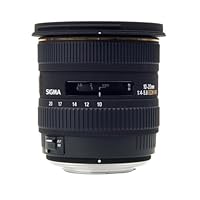
Average Reviews:

(More customer reviews)I went into a local camera store to look at the Nikon 12-24mm wide angle zoom to eventually augment the Nikon 50mm 1.8 and 18-200mm VR I currently use on my D200. After seeing the Sigma 10-20mm, taking test shots with it and the Nikon, and then printing the shots in the store, I walked out with the Sigma lens.
I had planned to buy the 12-24mm Nikon next Spring when my budget would allow the expenditure. I have had success with Nikon optics in the past - starting with my first Nikon FM back in the seventies. The Sigma's good construction, nice finish, smooth+fast+quiet focusing and 10mm focal length convinced me to try my first non-Nikon lens in 30 years. A big factor: The Sigma lens is less than half the price of the Nikon lens here is Canada. It fit my budget, so I took the plunge.
The Sigma fits into my "sharp enough" category. In real world shooting, its sharpness is on par with my 18-200mm Nikon. Both lens are less sharp than my $100 50mm 1.8 when "test" images are blown up to 16"x20" size. I never notice any lack of sharpness in "real" pictures. I care more about color saturation, contrast and color balance anyway. In this area, the Sigma does well. Saturation and contrast are equal to both my other Nikon lens - particularly at f8 and smaller aperatures. Wide open, I find some weakening in contrast. The Sigma has a warmer color termperature than my other lens. One click toward blue in Photoshop would fix this minor variance in color. But I use my 10-20mm almost exclusively for landscapes. The warmer color is generally a good thing.
I have noticed some vignetting @ 10mm f4. Zooming to 12mm or stopping down to f5.6 elminates any artifacts in pictures I have taken thus far. I have found it's more important to avoid "thick framed" filters - and stacking filters is a no no with this lens. They cause more darkening than a wide open f-stop. BTW: I added a 72 to 77mm step-up ring to my 18-200m VR Nikon to allow me to share filters between my zoom lens.
I do miss having a manual/autofocus switch on the Sigma lens. I have accidently nudged the manual focus ring a couple of times. With that said, the incredible depth of field of this lens (or any lens at this focal length) means small focusing errors can be tolerated :)
I recommend this lens - even to people like me, who never had a non-nikon lens before.
Click Here to see more reviews about: Sigma 10-20mm f/4-5.6 EX DC HSM Lens for Canon Digital SLR Cameras
Designed exclusively for Canon digital SLR cameras, the ultra-wide-angle 10-20mm offers a view from 102.4 to 63.8 degrees, making it ideal for landscape photography and other vast applications. The lens is distinguished by its three special low dispersion (SLD) glass elements, which effectively compensate for color aberration, and its aspherical lenses, which provide maximum correction for distortion and various aberrations. As a result, the lens produces an extremely high image quality throughout the entire zoom range. The HSM-equipped models, meanwhile, produce fast autofocus (AF) speeds and quiet shooting while still letting you perform full-time manual focus. Other details include a minimum focusing distance of 9.4 inches at all focal lengths and an integral petal-type hood to block out extraneous light.
Lens Elements and Coating The new multilayer lens coating and lens design reduce flare and ghost--a common problem with digital cameras--while also creating an optimal color balance throughout the entire zoom range. At the same time, the lens offers three SLD glass elements that effectively compensate for color aberration, along with a piece of glass mold and two hybrid aspherical lenses that offer excellent correction for distortion and all types of aberration.
Inner Focusing System and HSM The lens incorporates an internal focusing system that eliminates front lens rotation, letting you use a petal-type hood to protect from additional glare. And models equipped with a Hyper-Sonic Motor (HSM) produce silent, high-speed autofocus and full-time manual focus for Sigma, Canon, and Nikon D-mount lenses.
Best Consumer Lens The Sigma 10-20mm lens is so respected that it was named the best consumer lens in Europe (2006) by the Technical Image Press Association (TIPA), a collection of 31 publications from 12 countries. According to TIPA, the 10-20mm lens offers a versatile range of wide-angle focal lengths, a good optical performance, and a budget price, making it an excellent investment for owners of DSLRs with APS-C format sensors. Its sharpness remains constant throughout the zoom range, and its compact size makes it an ideal companion for shooting travel, landscapes, or architectural subjects.
Lens construction: 14 elements in 10 groups
Angle of view: 102.4 to 63.8 degrees
Number of diaphragm blades: 6
Minimum aperture: f/22
Minimum focusing distance: 9.4 inches
Maximum magnification: 1:6.7
Filter size: 77mm
Dimensions: 3.3 inches in diameter and 3.2 inches long
Weight: 16.4 ounces

0 comments:
Post a Comment